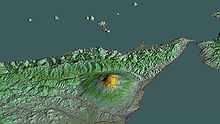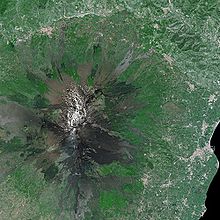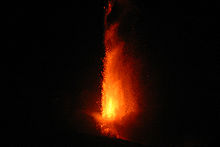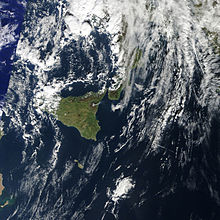- Mount Etna
-
Mount Etna
Mount Etna viewed from the SW.Elevation 3,329 m (10,922 ft) (varies)[1] Width of cone – 40 km approx Prominence 3,329 m (10,922 ft) Listing Ultra Location Sicily, Italy Coordinates 37°45′18.24″N 14°59′42.9″E / 37.7550667°N 14.99525°ECoordinates: 37°45′18.24″N 14°59′42.9″E / 37.7550667°N 14.99525°E[1] Geology Type Stratovolcano (composite type) Age of rock 500,000 years Last eruption 23 October 2011 Climbing Easiest route rock climb Mount Etna is an active stratovolcano on the east coast of Sicily, close to Messina and Catania. It is the tallest active volcano in Europe, currently standing 3,329 m (10,922 ft) high, though this varies with summit eruptions; the mountain is 21 m (69 ft) higher than it was in 1981.[citation needed]. It is the highest mountain in Italy south of the Alps. Etna covers an area of 1,190 km² (460 sq mi) with a basal circumference of 140 km. This makes it by far the largest of the three active volcanoes in Italy, being about two and a half times the height of the next largest, Mount Vesuvius. Only Mount Teide in Tenerife surpasses it in the whole of the European-North-African region.[2] In Greek Mythology, the deadly monster Typhon was trapped under this mountain by Zeus, the god of the sky, and the forges of Hephaestus were said to also be located underneath it.
Mount Etna is one of the most active volcanoes in the world and is in an almost constant state of activity. The fertile volcanic soils support extensive agriculture, with vineyards and orchards spread across the lower slopes of the mountain and the broad Plain of Catania to the south. Due to its history of recent activity and nearby population, Mount Etna has been designated a Decade Volcano by the United Nations.[3]
Contents
Etymology
According to Adrian Room’s book Place-names of the World, the name Etna is said to have originated from a Phoenician word attuna meaning "furnace." He dismisses the theory that Etna is from a Greek source meaning "I burn."[4] In Classical Greek, it is called Αἴτνη (Aítnē),[5] and Aetna in Latin. It is also known as Muncibeddu in Sicilian and Mongibello in Italian (from the Latin mons and the Arabic gibel, both meaning mountain[6]). Its Arabic name was Ǧabal al-Nār ("the Mountain of Fire").[7]
Geological history
 Etna 3D
Etna 3D

Volcanic activity first took place at Etna about half a million years ago, with eruptions occurring beneath the sea off the ancient coastline of Sicily.[8] About 300,000 years ago, volcanism began occurring to the southwest of the summit (centre top of volcano) then, before activity moved towards the present center 170,000 years ago. Eruptions at this time built up the first major volcanic edifice, forming a stratovolcano in alternating explosive and effusive eruptions. The growth of the mountain was occasionally interrupted by major eruptions, leading to the collapse of the summit to form calderas.
From about 35,000 to 15,000 years ago, Etna experienced some highly explosive eruptions, generating large pyroclastic flows, which left extensive ignimbrite deposits. Ash from these eruptions has been found as far away as Rome, 800 km to the north.
Thousands of years ago, the eastern flank of the mountain experienced a catastrophic collapse, generating an enormous landslide in an event similar to that seen in the 1980 eruption of Mount St. Helens. The landslide left a large depression in the side of the volcano, known as 'Valle del Bove' (Valley of the Ox). Research published in 2006 suggested this occurred around 6000 BC, and caused a huge tsunami, which left its mark in several places in the eastern Mediterranean. It may have been the reason the settlement of Atlit Yam (Israel), now below sea level, was suddenly abandoned around that time.[9]
The steep walls of the valley have suffered subsequent collapses on numerous occasions. The strata exposed in the valley walls provide an important and easily accessible record of Etna's eruptive history.
The most recent collapse event at the summit of Etna is thought to have occurred about 2,000 years ago, forming what is known as the Piano Caldera. This caldera has been almost entirely filled by subsequent lava eruptions, but is still visible as a distinct break in the slope of the mountain near the base of the present-day summit cone.
Eruption
Historical eruptions
Eruptions of Etna are not always the same. Most occur at the summit, where there are currently (as of 2008)[update] four distinct craters—the Northeast Crater, the Voragine, the Bocca Nuova, and the Southeast Crater. Other eruptions occur on the flanks, where there are more than 300 vents, ranging in size from small holes in the ground to large craters hundreds of metres across. Summit eruptions can be highly explosive and are extremely spectacular, but are rarely threatening for the inhabited areas around the volcano. On the contrary, flank eruptions can occur down to a few hundred metres altitude, close to or even well within the populated areas. Numerous villages and small towns lie around or on cones of past flank eruptions. Since the year 1600 A.D., there have been at least 60 flank eruptions and countless summit eruptions; nearly half of these have occurred since the start of the 20th century, and the 3rd millennium has seen four flank eruptions of Etna so far, in 2001, 2002–2003, 2004–2005, 2008-2009. Summit eruptions occurred in 2006, 2007–2008 and again in January 2011.
The first known record of eruption at Etna is that of Diodorus Siculus.
The Roman poet Virgil gave what was probably a first-hand description of an eruption in the Aeneid
“ A spreading bay is there, impregnable To all invading storms; and Aetna's throat With roar of frightful ruin thunders nigh. Now to the realm of light it lifts a cloud Of pitch-black, whirling smoke, and fiery dust, Shooting out globes of flame, with monster tongues That lick the stars; now huge crags of itself, Out of the bowels of the mountain torn, Its maw disgorges, while the molten rock Rolls screaming skyward; from the nether deep The fathomless abyss makes ebb and flow.
” (edition of Theodore C. Williams, ca. 1908 [lines 569–579])
In 396 BC, an eruption of Etna is said to have thwarted the Carthaginians in their attempt to advance on Syracuse during the Second Sicilian War.
A particularly violent explosive (Plinian) summit eruption occurred in 122 BC, and caused heavy tephra falls to the southeast, including the town of Catania, where many roofs collapsed.[10] To help with reconstruction and dealing with the devastating effects of the eruption, the Roman government exempted the population of Catania from paying taxes for ten years.
During the first 1500 years CE (AD), many eruptions have gone unreported (or records have been lost); among the more significant are: (1) an eruption in about 1030 CE near Monte Ilice on the lower southeast flank, which produced a lava flow that travelled about 10 km reaching the sea north of Acireale; the villages of Santa Tecla and Stazzo are built on the broad delta built by this lava flow into the sea; (2) an eruption in about 1160 (or 1224), from a fissure at only 350–450 m elevation on the south-southeast flank near the village of Mascalucia, whose lava flow reached the sea immediately to the north of Catania, in the area now occupied by the portion of the city named Ognina.
Etna's most destructive eruption since 122 BC started on 11 March 1669, and produced lava flows that destroyed at least 10 villages on its southern flank before reaching the city walls of the town of Catania five weeks later, on 15 April. The lava was largely diverted by these walls into the sea to the south of the city, filling the harbor of Catania. A small portion of lava eventually broke through a fragile section of the city walls on the western side of Catania and destroyed a few buildings before stopping in the rear of the Benedictine monastery, without reaching the center of the town. Contrary to widespread reports of up to 15,000 (or even 20,000) human fatalities caused by the lava,[11] contemporaneous accounts written both in Italian and English mention no deaths related to the 1669 eruption (but give very precise figures of the number of buildings destroyed, the area of cultivated land lost, and the economic damage), so it can be safely assumed that the enormous number of fatalities often picked up also by the news media must be a confusion with the devastating earthquake that devastated southeast Sicily (including Catania) 24 years later, in 1693. A study on the damage and fatalities caused by eruptions of Etna in historical time reveals that only 77 human deaths can be attributed with certainty to eruptions of Etna, most recently in 1987 when two tourists were killed by a sudden explosion near the summit.[12]
Recent Eruptions
Another large lava flow from an eruption in 1928 led to the first (and only) destruction of a population centre since the 1669 eruption. The eruption started high on Etna's northeast flank on November 2, then new eruptive fissures opened at ever lower elevation down the flank of the volcano. The third and most vigorous of these fissures opened late on 4 November at an unusually low elevation (1200 m above sea-level), in a zone known as Ripe della Naca. The village of Mascali, lying downslope of the Ripe della Naca, was obliterated in just two days, with the lava destroying nearly every building. Only a church and a few surrounding buildings survived in the north part of the village, called Sant'Antonino or "il quartiere". During the last days of the eruption, the flow interrupted the Messina-Catania railway line and destroyed the train station of Mascali. The event was used by Benito Mussolini's Fascist regime for propaganda purposes, with the evacuation, aid and rebuilding operations being presented as models of fascist planning. Mascali was rebuilt on a new site, and its church contains the Italian fascist symbol of the torch, placed above the statue of Jesus Christ. In early November 2008, the town of Mascali commemorated the 80th anniversary of the eruption and destruction of the village with a number of public manifestations and conferences where amongst others still living eyewitnesses of the eruptions recalled their impressions of that experience.
Other major 20th-century eruptions occurred in 1949, 1971, 1981, 1983 and 1991–1993. In 1971, lava buried the Etna Observatory (built in the late 19th century), destroyed the first generation of the Etna cable-car, and seriously threatened several small villages on Etna's east flank. In March 1981, the town of Randazzo on the northwestern flank of Etna narrowly escaped from destruction by unusually fast-moving lava flows – that eruption was remarkably similar to the one of 1928 that destroyed Mascali. The 1991–1993 eruption saw the town of Zafferana threatened by a lava flow, but successful diversion efforts saved the town with the loss of only one building a few hundred metres from the town's margin. Initially, such efforts consisted of the construction of earth barriers built perpendicularly to the flow direction; it was hoped that the eruption would stop before the artificial basins created behind the barriers would be completely filled. Instead, the eruption continued, and lava surmounted the barriers, heading directly toward Zafferana. It was then decided to use explosives near the source of the lava flow, to disrupt a very efficient lava tube system through which the lava travelled for up to 7 km without essentially losing heat and fluidity. The main explosion on 23 May 1992 destroyed the lava tube and forced the lava into a new artificial channel, far from Zafferana, and it would have taken months to re-establish a long lava tube. Shortly after the blasting, the rate of lava emission dropped and during the remainder of the eruption (until 30 March 1993) the lava never advanced close to the town again.[13]
Following six years (1995–2001) of unusually intense activity at the four summit craters of Etna, the volcano produced its first flank eruption since 1991–1993 in July–August 2001. This eruption, which involved activity from seven distinct eruptive fissures mostly on the south slope of the volcano, was a mass-media eruption, because it occurred at the height of the tourist season and numerous reporters and journalists were already in Italy to cover the G8 summit in Genoa. It also occurred close to one of the tourist areas on the volcano, and thus was easily accessible. Part of the "Etna Sud" tourist area, including the arrival station of the Etna cable car, were damaged by this eruption, which otherwise was a rather modest-sized event for Etna standards.
In 2002–2003, a much larger eruption threw up a huge column of ash that could easily be seen from space and fell as far away as Libya, 600 km (370 mi) south across the Mediterranean Sea. Seismic activity in this eruption caused the eastern flanks of the volcano to slip by up to two metres, and many houses on the flanks of the volcano experienced structural damage. The eruption also completely destroyed the tourist station Piano Provenzana, on the northeastern flank of the volcano, and part of the tourist station "Etna Sud" around the Rifugio Sapienza on the south flank. Footage from the eruptions was recorded by Lucasfilm and integrated into the landscape of the planet Mustafar in the 2005 film Star Wars Episode III: Revenge of the Sith.[14] The Rifugio Sapienza is near the site of a cable car station which had previously been destroyed in the 1983 eruption; it has now been rebuilt. Following a rather silent, slow and non-destructive lava outflow on the upper southeastern flank between September 2004 and March 2005, intense eruptions occurred at the Southeast Crater in July–December 2006. These were followed by four episodes of lava fountaining, again at the Southeast Crater, on 29 March, 11 April, 29 April and 7 May 2007. Ash emissions and Strombolian explosions started from a vent on the eastern side of the Southeast Crater in mid-August 2007.
On 4 September 2007 a spectacular episode of lava fountaining occurred from the new vent on the east side of the Southeast Crater, also producing a plume of ash and scoriae which fell over the east flank of the volcano. A lava flow travelled about 4.5 km into the uninhabited Valle del Bove. This eruption was visible far into the plains of Sicily, ending the following morning between the hours of 5 to 7 am local time. Catania-Fontanarossa Airport shut down operations during the night for safety precautions. A similar paroxysm occurred during the night of 23–24 November 2007, lasting for 6 hours and causing ash and lapilli falls to the north of the volcano. Again, the source of the activity was the vent on the east flank of the Southeast Crater. Following several months of rather minor activity from the Southeast Crater and flurries of seismic activity especially in the eastern sector of the mountain, a new powerful eruptive paroxysm occurred on the late afternoon of 10 May 2008. Due to bad weather, it was not possible to see much of the activity at the vent, but several branches of lava travelled down the eastern flank of the volcano, into the Valle del Bove depression, reaching a length of 6.2 km. This latest paroxysm lasted about 4 hours, ending on the evening of 10 May 2008.
An eruption on the morning of 13 May 2008, immediately to the east of Etna's summit craters was accompanied by a swarm of more than 200 earthquakes and significant ground deformation in the summit area. The eruption continued at a slowly diminishing rate for 417 days, until 6 July 2009, making this the longest flank eruption of Etna since the 1991–1993 eruption that lasted 473 days. Previous eruptions, in 2001, 2002–2003, and 2004–2005 had lasted 3 weeks, 3 months, and 6 months, respectively. Lava flows advanced 6.5 km during the first few days of this eruption but thereafter stagnated at much minor distances from the vents; during the last months of the eruption lava rarely advanced more than 1 km downslope.
During the year 2010, the summit craters of Etna were the site of intermittent, minor explosive activity, which produced only minor quantities of ash and no lava flows. The most significant events were a single explosion from the vent on the east flank of the Southeast Crater cone on 7 April, a sequence of explosions from the western pit of the Bocca Nuova that started on 25 August and continued until 22 December, and ash emissions from the Northeast Crater on 14–15 November. The vent on the east side of the Southeast Crater cone became again active in late December; activity then intensified in early January 2011.
On 13 January 2011, a new episode of lava fountaining occurred from the vent on the east flank of the Southeast Crater cone, lasting about 1.5 hours. Italian Authorities were forced to temporarily close airports for a couple of hours while the ash cloud cleared. The event was well visible during the clear, moonlit night and attracted numerous spectators in eastern Sicily and as far as southern Calabria.[15][16]
The volcano has been sputtering with abundant steam and ash plumes and some strombolian explosions in the southeast pit crater on the morning of 8 May 2011, generating loud detonations that were audible to many kilometres away, such as the Monti Sartorius (northeast flank) and the town of Zafferana Etnea. After sunset, Strombolian explosions were seen to occur at intervals of 3–10 minutes, ejecting incandescent bombs up to a few tens of metres above the crater rim. During the night, some explosions threw bombs well beyond the crater rim, down to the base of the cone that has grown around the crater during the recent paroxysms. This activity continued on the morning of 9 May, without any change in the frequency and size of the explosions and no variation was seen in the seismic activity either. On 11 May, this activity rapidly increased and some lava started to spill over the low eastern rim of the crater.[17] Then, around 0300h in the morning on 12 May (local time = GMT+2), the fourth lava fountain of Etna in the year 2011 burst into the night sky. For many hours, there had been increasingly vigorous Strombolian activity and a small lava flow, and the amplitude of volcanic tremor was rising. The fountain lasted for a couple of hours and ended at daybreak—by 0600 h it was essentially over.[18][19]
Mount Etna erupted again in 2011 on July 9, 18 and 19, 24 and 25, 30 and 31, on August 5 and 6, 12, 20 and 29, on September 8, 19 and 28, on October 8 and 23, and on November 15, sending lava sprays several hundred metres into the air; no damage or casualties were reported.[20]
Unusual characteristics
In the 1970s Etna erupted smoke rings,[21] one of the first captured events of this type, which is extremely rare. This happened again in 2000.[22]
See also
Footnotes
- ^ a b The elevation varies with volcanic activity. It is frequently given as 3,350 m (10,990 ft), but many sources that support this concede that it is approximate. The coordinates given, which are consistent with SRTM data, are from a 2005 GPS survey. The elevation data are based on a LIDAR (Light Detection and Ranging) survey carried out in June 2007, see Neri, M.; et al. (2008), "The changing face of Mount Etna's summit area documented with Lidar technology", Geophysical Research Letters 35: L09305, Bibcode 2008GeoRL..3509305N, doi:10.1029/2008GL033740
- ^ "Italy volcanoes and Volcanics". USGS. http://vulcan.wr.usgs.gov/Volcanoes/Italy/description_italy_volcanics.html.
- ^ "Decade Volcanoes". United States Geological Survey. http://vulcan.wr.usgs.gov/Volcanoes/DecadeVolcanoes/framework.html.
- ^ "Volcano – Podictionary Word of the Day". Blog.oup.com. 2010-04-29. http://blog.oup.com/2010/04/volcano/. Retrieved 2011-06-02.
- ^ "Woodhouse's English-Greek Dictionary Page Image". Artflx.uchicago.edu. http://artflx.uchicago.edu/cgi-bin/efts/dicos/woodhouse_test.pl?pagenumber=1010&pageturn=1. Retrieved 2011-06-02.
- ^ (Italian) "Note di toponomastica". Archived from the original on 2009-03-27. http://web.archive.org/web/20090327012358/http://www.araldicacivica.it/pdf/toponomastica.pdf. Retrieved 2011-08-20.
- ^ Chevedden, Paul E. (2010), "A Crusade from the First: The Norman Conquest of Islamic Sicily, 1060-1091", Al-Masaq: Islam and the Medieval Mediterranean 22 (2), doi:10.1080/09503110.2010.488891
- ^ Martin-Schutz, Alicia. "Mt. Etna". http://vulcan.wr.usgs.gov/Volcanoes/Italy/description_italy_volcanics.html.
- ^ Pareschi, M. T.; Boschi, E. & Favalli, M. (2007), "Holocene tsunamis from Mount Etna and the fate of Israeli Neolithic communities", Geophysical Research Letters 34: L16317, Bibcode 2007GeoRL..3416317P, doi:10.1029/2007GL030717
- ^ Coltelli, M.; Del Carlo, P. & Vezzoli, L. (1998), "Discovery of a Plinian basaltic eruption of Roman age at Etna Volcano, Italy", Geology 26 (12): 1095–1098, doi:10.1130/0091-7613(1998)026<1095:DOAPBE>2.3.CO;2
- ^ "Mount Etna (volcano, Italy)". (the Encyclopædia Britannica has been wrongly cited as one source of this false information).
- ^ "Etna and Man". Boris.vulcanoetna.it. http://boris.vulcanoetna.it/ETNA_andman2.html. Retrieved 2011-06-02.
- ^ Barberi, F.; Carapezza, M. L.; Valenza, M.; Villari, L. (1993), "The control of lava flow during the 1991–1992 eruption of Mt. Etna", Journal of Volcanology and Geothermal Research 56 (1–2): 1–34, doi:10.1016/0377-0273(93)90048-V
- ^ "press_text_booklet.indd" (PDF). http://hollywoodjesus.com/movie/star_wars_ep_3/notes.pdf. Retrieved 2011-06-02.
- ^ Italy's Mt Etna erupts | WORLD News
- ^ Ken Kremer (2011-01-15). "Spectacular Eruptions of Mt. Etna in Sicily from Space and Earth". Universetoday.com. http://www.universetoday.com/82516/spectacular-eruptions-of-mt-etna-in-sicily-from-space-and-earth/. Retrieved 2011-06-02.
- ^ "INGV - Etna Observatory". Ct.ingv.it. http://www.ct.ingv.it/index.php?option=com_content&view=article&id=363. Retrieved 2011-06-02.
- ^ By etnaboris Boris Behncke+ Add Contact. "12nd May Etna eruprtion foto". Flickr.com. http://www.flickr.com/photos/etnaboris/5711951955/. Retrieved 2011-06-02.
- ^ "BBC News - Footage shows Mount Etna spewing lava and ash". Bbc.co.uk. 2011-05-12. http://www.bbc.co.uk/news/world-europe-13381243. Retrieved 2011-06-02.
- ^ "Sicily's Mount Etna erupts". The Telegraph. 2011-08-01. http://www.telegraph.co.uk/news/worldnews/europe/italy/8673686/Sicilys-Mount-Etna-erupts.html. Retrieved 2011-08-01.
- ^ http://www.stromboli.net/etna/etna00/etna0002photovideo-en.html Smoke rings generated by eruptions of Etna volcano
- ^ "Etna hoops it up". BBC News. 2000-03-31. http://news.bbc.co.uk/2/hi/science/nature/696953.stm. Retrieved 2008-10-09.
References
- "Etna". Global Volcanism Program, Smithsonian Institution. http://www.volcano.si.edu/world/volcano.cfm?vnum=0101-06=. Retrieved 2008-12-25.
- Chester, D. K.; Duncan, A. M., Guest, J. E., and Kilburn, C. R. J. (1985). Mount Etna: The Anatomy of a Volcano. Chapman and Hall. pp. 412 pp. ISBN 0-8047-1308-1.
External links
- Where Etna is monitored: Istituto Nazionale di Geofisica e Vulcanologia, Sezione di Catania
- Exhaustive coverage of Mt. Etna geology and history
- Mount Etna Live Webcams
- Mount Etna—Geological formation
- VR panorama
- Etna and man
 Sicily
SicilyProvinces
and places
History Politics and
governmentCulture and
heritageCuisine • Language • People • Music • Sicilian Baroque • Sicilian School • Sicilian cart • Coppola • Flags • Triskelion • Mount Etna • Chestnut Tree of One Hundred HorsesDecade Volcanoes Avachinsky · Colima · Etna · Galeras · Koryaksky · Mauna Loa · Merapi · Nyiragongo · Rainier · Sakurajima · Santa María · Taal · Teide · Ulawun · Unzen · VesuviusCategories:- Mountains of Sicily
- Volcanoes of the Mediterranean
- Volcanoes of Italy
- Stratovolcanoes
- Decade Volcanoes
- Pleistocene volcanoes
- Active volcanoes
- Locations in Greek mythology
- VEI-5 volcanoes
- Wine regions of Italy
Wikimedia Foundation. 2010.












